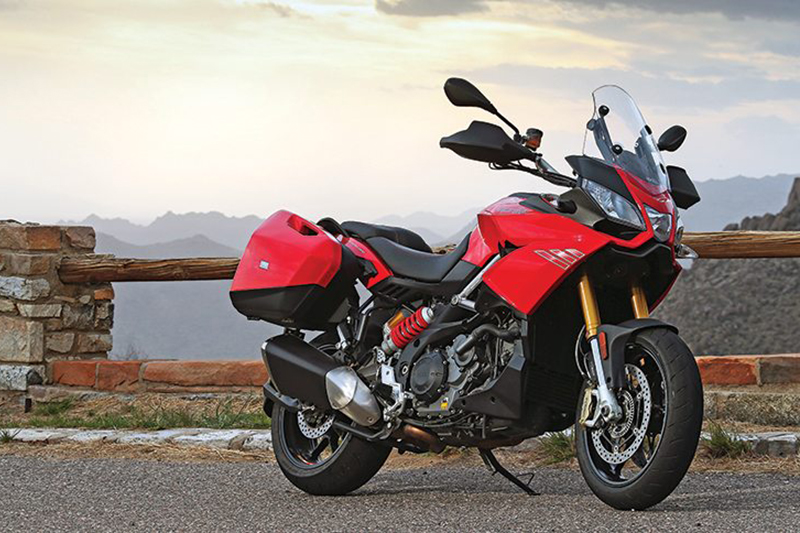2015 Aprilia Caponord 1200 ABS Travel Pack

Road Test Review
Norway’s Nordkapp (North Cape) is a 1,000-foot cliff overlooking the frigid Barents Sea, reached by riding through a 4.3-mile undersea tunnel on the world’s northernmost road. When you name a motorcycle Caponord, Italian for North Cape, you’re saying something about its touring capability. Aprilia first used the appellation on its 2002 ETV1000 Caponord, an adventure tourer powered by a detuned version of the Rotax-built 60-degree V-twin from its RSV Mille superbike. We didn’t ride it to the land of the midnight sun, but after flogging the first Caponord for several thousand miles, we deemed it a “quality, competent, fun-to-ride machine” (Rider, October 2001). Alas, sales were poor and it was dropped from Aprilia’s lineup for 2008.
Since then, Aprilia has been busy expanding its model range, building its own engines and winning two World Superbike championships. It has also been on the forefront of new technology, equipping its RSV4 and Tuono sportbikes with throttle-by-wire power modes and Aprilia Performance Ride Control (APRC), an electronics package featuring traction control, wheelie control, launch control and a quick shifter. Given the recent surge in popularity of adventure-touring bikes, it comes as no surprise that Aprilia revived the Caponord for 2015. But unlike the ETV1000, which had a 19-inch front wheel, spoked rims with dual-sport tires and a large plastic engine guard, the new Caponord has no off-road pretensions. It’s a sport tourer in adventure-touring clothing, combining corner-strafing performance with the styling, ergonomics and long-travel suspension of a big dualie. Lightweight 17-inch wheels shod with sticky Dunlop Sportmax Qualifier II tires and the lack of an enduro setting among its engine modes reveal the Caponord’s true colors.
Everything about the loquaciously labeled Caponord 1200 ABS Travel Pack is a departure from its predecessor, from its sleek bodywork (sharing squinty triple headlights with the RSV4 and Tuono) to its steel-and-aluminum frame and 1,200cc V-twin (adapted from the Dorsoduro 1200, a super-sized supermoto not sold in the U.S.). A bunny’s litter of acronyms—RbW, ABS, ATC, ACC and ADD—are shorthand for its full complement of electronics: ride-by-wire, anti-lock braking system, Aprilia Traction Control, Aprilia Cruise Control and Aprilia Dynamic Damping. All this whiz-bang gadgetry is standard equipment on the Travel Pack model, the only version available in the U.S., along with 29-liter color-matched saddlebags and a centerstand. A comfortable two-up seat with passenger grab handles, a manually adjustable windscreen, trip computer, 6.3-gallon fuel tank, 690-watt generator and hand guards round out the Caponord’s touring amenities, making a long ride to the North Cape sound like a walk in the park.
Whereas the 184-horsepower, 1,000cc V-4 in the RSV4 and Tuono is frighteningly ferocious, the Caponord’s 1,197cc 90-degree V-twin is a throbbing, torquey example of all that is joyful and triumphant about internal combustion. It lopes at idle, purrs at cruising speeds and rumbles mightily at full honk, with a single exhaust pipe that exudes sonorous thunder. Modest vibration creeps into the rider triangle and a hint of engine heat is felt on the right side, but neither is bothersome. Cooling is liquid, camshafts are double overhead, and four valves, two spark plugs, dual injectors and a 52mm throttle body serve each cylinder. Aprilia claims 125 horsepower at 8,250 rpm and 85 lb-ft of torque at 6,800 rpm, with peak torque sitting atop a broad plateau that spreads across the rev range. The engine stumbles a bit at low revs, but is strong and eager from 3,000 rpm up to the 9,000 rpm redline (discovered by smacking abruptly into the rev limiter; the digital tachometer goes up to 12,000 rpm and there’s no redline on the display). Clutch pull is firm, but otherwise shifting the 6-speed transmission is a breeze, and chain final drive reduces weight but requires regular maintenance.
Pressing the starter button allows the rider to alternate between three engine modes on the fly, though the throttle must be closed for changes to take effect. “Sport” delivers full power with rapid throttle response, “Touring” delivers full power with softer throttle response, and “Rain” limits output to 100 horsepower for slippery conditions. Sport mode is exciting but demands finesse due to on/off throttle abruptness at lower revs, and Rain mode came in handy on a gravel road but was otherwise unnecessary in drought-stricken Southern California, so I spent most of my time in user-friendly Touring mode. On the right switchpod are buttons for the easy-to-use cruise control and optional three-level heated grips. Small buttons next to the instrument panel, which are functional only when the bike is stopped, cycle through menus to change rear preload, traction control (three levels or off) and ABS (on/off).
German suspension manufacturer Sachs builds adaptive suspension systems for BMW and Ducati that adjust damping automatically in response to changing road and riding conditions. These systems are called “semi-active” because the rider must adjust spring preload, either manually or with pushbutton presets. The Caponord’s Sachs-made Aprilia Dynamic Damping system features four patented innovations: a fork air-pressure sensor to measure stroke, a “comfort oriented” damping algorithm, “map-builder” software that controls ADD and—offered for the first time on a production motorcycle—a fully active rear shock that automatically adjusts both damping and preload. While other semi-active systems allow the rider to choose preset damping levels ranging from soft to hard, ADD is a single-map system designed to provide the best setting in every condition. Since damping adjusts automatically, all the rider has left to do is change spring preload—manually on the fork and by selecting automatic mode or presets (solo, solo plus luggage, two-up, two-up plus luggage) for the rear shock.
For sport touring, ADD works very well. With 6.6 inches of travel on the 43mm male-slider fork and 5.9 inches of travel on the horizontally mounted shock, the suspension absorbs everything from minor pavement ripples to major frost-heaved, maintenance-deferred undulations. The “comfort oriented” damping lives up to its name with ample plushness and excellent chassis stability. At a sporting pace I wished for more firmness, but only when I was really caning it. Automatic preload adjustment is a very useful feature, though I grew tired of the instrument display constantly cycling through the icons for helmets and luggage when in that mode.
Connecting the Caponord’s V-twin and suspension is a robust tubular-steel trellis frame with die-cast aluminum side plates and a cast aluminum swingarm, and supporting the seat and saddlebags is a tubular-steel subframe. The tail section is slender and attractive with the saddlebags removed, and the exhaust pipe can be raised for more cornering clearance. Stability-oriented steering geometry (26.1-degree rake, 4.9-inch trail) and a rangy 61.6-inch wheelbase make the Caponord reluctant to turn-in, but its wide handlebar provides plenty of steering leverage and the bike holds a line well. Fantastic Brembo brakes—320mm front discs clamped by M432 radial monobloc 4-piston calipers and a single 240mm rear disc squeezed by a 1-piston caliper—and standard, two-channel ABS are able to freeze-frame blurry scenery with good feedback at the lever.
Like other adventure bikes, the Caponord has a neutral riding position with ample legroom and an easy reach to the handlebar. The wide, flat seat is 33.1 inches high, fine for my 34-inch inseam but a stretch for those of average or lower height (an accessory low seat is available). Thickly padded seats pamper both the rider and passenger; I logged an 11-hour, 550-mile backroad test ride without complaint. Hand guards and a small, height-adjustable windscreen provide decent wind protection, but wind noise and turbulence become tiresome at speed. For long-haul touring, a windscreen with more coverage (Aprilia doesn’t yet offer one) and higher-mileage tires—the rear Qualifier II was down to its wear bars after just 2,500 miles—would be sensible upgrades. A top trunk, tankbag, heated grips and other accessories are available. Android and iPhone smartphone users can download the Aprilia Multimedia Platform app and pair it to their bike via Bluetooth (an optional $259.90 ECU and wiring kit is required). The app includes the Caponord owner’s manual (bring your reading glasses) and, when the phone is mounted on the bike, provides additional dash display, navigation and trip functions.
Fast, comfortable and well equipped, the Aprilia Caponord 1200 ABS Travel Pack is a sport tourer with Italian flair and state-of-the-art technology. Except for ABS, which is a “need to have” feature on modern, powerful street bikes, the rest of the Caponord’s electronics fall into the “nice to have” category. Once I figured out my favorite settings—Touring mode, traction control level 1 and automatic rear preload adjustment—I let the electronics do their thing in the background while I enjoyed the ride. With such agreeable ergonomics and good fuel range (221 miles based on our 35 mpg average), stops became a matter of desire rather than need. Another attractive feature of the Caponord, especially given its high level of componentry and specification, is its $15,499 price, which is $4,500 less than a comparably equipped Ducati Multistrada 1200 S Touring. So whether you’re headed to the North Cape or the north side of town, the Caponord is ready. Don’t forget your scarf.
